 | | | Switch to: Europe, USA, New Zealand, Antarctica Credit: NOAA/Ovation  Planetary K-index Planetary K-index
Now: Kp= 2.67 quiet
24-hr max: Kp= 3.67 quiet
explanation | more data
Interplanetary Mag. Field
Btotal: 10.18 nT
Bz: -4.75 nT south
more data: ACE, DSCOVR
Updated: Today at 1147 UT  Coronal Holes: 01 May 24 Coronal Holes: 01 May 24 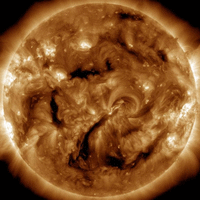
There are no significant equatorial coronal holes on the Earthside of the sun. Credit: SDO/AIA  Polar Stratospheric Clouds
Colorful Type II polar stratospheric clouds (PSC) form when the temperature in the stratosphere drops to a staggeringly low -85C. NASA's MERRA-2 climate model predicts when the air up there is cold enough: 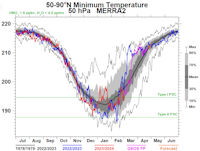
On Apr. 30, 2024, the Arctic stratosphere is much too warm for Type II polar stratospheric clouds. | more data. Noctilucent Clouds
The southern season for NLCs is over. The first clouds were detected inside the Antarctic Circle on Dec. 4, 2023, by the NOAA 21 satellite. The same satellite detected the last cloud on Feb. 21, 2024. Daily maps are now blank:
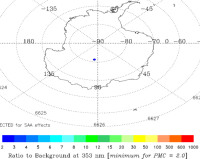
Updated: Feb 22, 2024
An instrument onboard NOAA 21 (OMPS LP) is able to detect NLCs (also known as "polar mesospheric clouds" or PMCs). Now that the southern season has ended, attention turns to the northern hemisphere. The first NLCs should appear inside the Arctic Circle in mid to late May.
 SPACE WEATHER
NOAA Forecasts | | Updated at: 2024 May 01 2200 UTC FLARE | 0-24 hr | 24-48 hr | CLASS M | 55 % | 40 % | CLASS X | 10 % | 05 % |  Geomagnetic Storms: Geomagnetic Storms:
Probabilities for significant disturbances in Earth's magnetic field are given for three activity levels: active, minor storm, severe storm Updated at: 2024 May 01 2200 UTC Mid-latitudes | 0-24 hr | 24-48 hr | ACTIVE | 30 % | 30 % | MINOR | 10 % | 10 % | SEVERE | 01 % | 01 % | High latitudes | 0-24 hr | 24-48 hr | ACTIVE | 15 % | 15 % | MINOR | 25 % | 25 % | SEVERE | 40 % | 40 % | | | |  | | | | | | | | | | | This is an AI Free Zone! Text created by Large Language Models is spreading rapidly across the Internet. It's well-written, artificial, frequently inaccurate. If you find a mistake on Spaceweather.com, rest assured it was made by a real human being. | | | SOLAR FLARE AND RADIO BLACKOUT (UPDATED): Active sunspot AR3654 exploded on April 30th (2345 UT), producing an M9.5-class flare only percentage points from category X. Ham radio operators and mariners observed a shortwave radio blackout around the Pacific Ocean (map). The explosions did *not* produce a significant CME. Solar flare alerts: SMS Text COMET 12P/PONS-BROOKS AND THE SOLAR WIND:"Solar wind" is a relatively new idea. The first scientist to think of it may have been Sir. Arthur Eddington who, in 1910, suggested that Comet Morehouse might be shaped by some unseen gaseous outflow from the sun. Astronomers didn't think much of his suggestion. It might have been an easier sell if they had seen this picture of Comet 12P/Pons-Brooks: 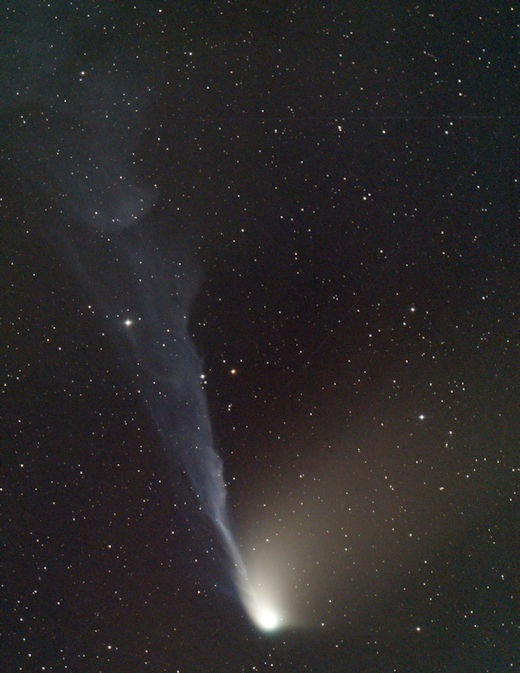
Michael Mattiazzo photographed the comet on April 30th from Swan Hill, Victoria, Australia. "The comet's tail is incredibly active," he says. Most of the ripples, curls and streamers captured so beautifully in Mattiazzo's photo are caused by the buffeting of solar wind. Not only that, the comet's tail is pointing directly away from the sun--another sign that Eddington's "outflow" really exists. Eventually, Eddington's idea started to catch on among other researchers, although it was a slow process with widespread acceptance taking almost 50 years. American astrophysicist Eugene Parker coined the term "solar wind" around 1957. In January 1959, the Soviet spacecraft Luna 1 directly observed the solar wind and measured its strength for the first time. This month, amateur astronomers in the southern hemisphere can behold the effects of solar wind with their own eyes. Comet 12P/Pons-Brooks is emerging from an April close encounter with the sun (perihelion), and its wind-sculpted tail is a beautiful sight through backyard telescopes. Point your optics here. more images: from Mike White of Twizel, New Zealand
Realtime Space Weather Photo Gallery
Free: Spaceweather.com Newsletter TAHITIAN BLACK SOLAR ECLIPSE PEARL: It came from Tahiti, and now it has touched the shadow of the Moon. On April 8, 2024, the students of Earth to Sky Calculus launched this black pearl into a total eclipse of the sun over Texas. Riding on a cosmic ray research balloon, the pearl was 86,564 feet high when lunar darkness swallowed it for 3 minutes 45 seconds: 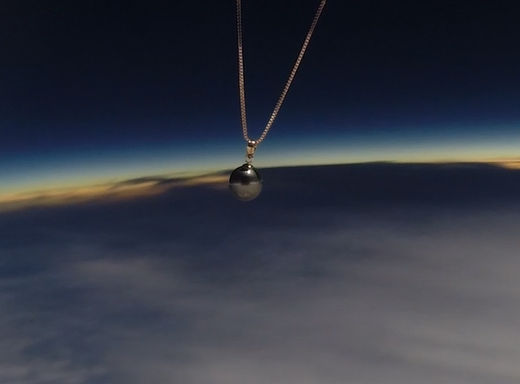
You can have it for $299.95. Measuring 9 mm in diameter, this genuine Tahitian pearl has an 18K rose gold clasp and is suspended from a matching 925 Sterling Silver chain. It comes with a greeting card showing the pearl in flight and telling the story of its journey to the edge of space during the 2024 total eclipse.
Far Out Gifts: Earth to Sky Store
All sales support hands-on STEM education
Realtime Comet Photo Gallery
Free: Spaceweather.com Newsletter
Realtime Aurora Photo Gallery
Free: Spaceweather.com Newsletter
Every night, a network of NASA all-sky cameras scans the skies above the United States for meteoritic fireballs. Automated software maintained by NASA's Meteoroid Environment Office calculates their orbits, velocity, penetration depth in Earth's atmosphere and many other characteristics. Daily results are presented here on Spaceweather.com. On May 01, 2024, the network reported 6 fireballs.
(5 sporadics, 1 eta Aquarid) 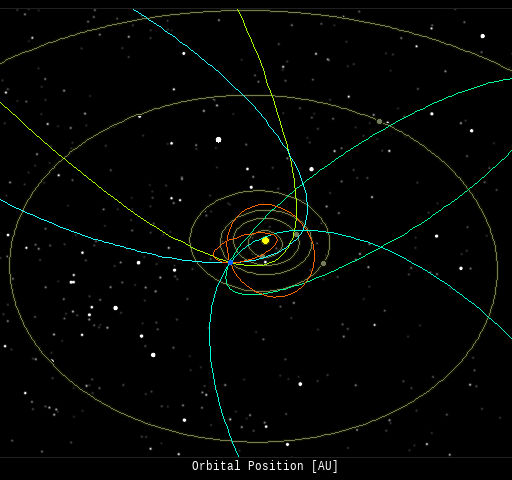 In this diagram of the inner solar system, all of the fireball orbits intersect at a single point--Earth. The orbits are color-coded by velocity, from slow (red) to fast (blue). [Larger image] [movies] Potentially Hazardous Asteroids ( PHAs) are space rocks larger than approximately 100m that can come closer to Earth than 0.05 AU. None of the known PHAs is on a collision course with our planet, although astronomers are finding new ones all the time. On May 1, 2024 there were 2349 potentially hazardous asteroids.
 | Recent & Upcoming Earth-asteroid encounters: | Asteroid | Date(UT) | Miss Distance | Velocity (km/s) | Diameter (m) | | 2024 HL1 | 2024-Apr-26 | 0.4 LD | 12.1 | 22 | | 2024 HX1 | 2024-Apr-26 | 4.9 LD | 16 | 18 | | 2024 FG5 | 2024-Apr-26 | 12.5 LD | 9.1 | 35 | | 2024 HT1 | 2024-Apr-26 | 0.9 LD | 16.4 | 44 | | 2024 HT | 2024-Apr-26 | 17.3 LD | 9.4 | 30 | | 2024 GR1 | 2024-Apr-27 | 19.6 LD | 7.2 | 52 | | 2024 HU1 | 2024-Apr-27 | 2.1 LD | 11 | 21 | | 2024 HF2 | 2024-Apr-27 | 7.8 LD | 9 | 18 | | 2024 HF1 | 2024-Apr-28 | 5 LD | 10.9 | 25 | | 2024 GS4 | 2024-Apr-28 | 10.6 LD | 12.8 | 33 | | 2024 GK5 | 2024-Apr-29 | 12.9 LD | 5.2 | 39 | | 2024 HO2 | 2024-Apr-29 | 0.1 LD | 9.2 | 4 | | 2021 GD3 | 2024-Apr-30 | 11.2 LD | 3.5 | 14 | | 2024 HQ1 | 2024-Apr-30 | 2.2 LD | 5.5 | 8 | | 2022 TN1 | 2024-Apr-30 | 18.6 LD | 17.7 | 314 | | 2024 HK2 | 2024-May-01 | 7.6 LD | 18.3 | 26 | | 2022 AA5 | 2024-May-03 | 13.5 LD | 9 | 67 | | 2024 HK1 | 2024-May-04 | 1.8 LD | 8.6 | 31 | | 2024 HV1 | 2024-May-05 | 3.4 LD | 8.8 | 21 | | 2024 HW1 | 2024-May-05 | 5 LD | 11 | 20 | | 2024 FR5 | 2024-May-05 | 4.9 LD | 5.2 | 49 | | 2024 HL2 | 2024-May-06 | 7.6 LD | 13.5 | 25 | | 2024 HM2 | 2024-May-06 | 17.5 LD | 25.2 | 55 | | 2024 HE2 | 2024-May-06 | 3.2 LD | 12.1 | 25 | | 2021 JG9 | 2024-May-10 | 16.9 LD | 16.1 | 32 | | 2016 FT14 | 2024-May-10 | 19.9 LD | 5.9 | 39 | | 2015 KJ19 | 2024-May-14 | 15.8 LD | 23.1 | 112 | | 2014 WF6 | 2024-May-14 | 7.2 LD | 18.9 | 47 | | 2021 JN10 | 2024-May-14 | 17.5 LD | 13.2 | 33 | | 2021 JJ | 2024-May-15 | 16.8 LD | 5.7 | 28 | | 2022 WN2 | 2024-May-17 | 13.7 LD | 5.5 | 6 | | 2019 VB5 | 2024-May-21 | 7.8 LD | 6.3 | 2 | | 2024 HP | 2024-May-23 | 15.5 LD | 7.7 | 208 | | 2024 HP2 | 2024-May-24 | 5.8 LD | 2.3 | 20 | | 2008 LD | 2024-May-28 | 7.7 LD | 4.5 | 6 | | 2021 LV | 2024-May-29 | 12 LD | 15.5 | 9 | | 1998 KY26 | 2024-Jun-01 | 12 LD | 5.3 | 25 | | 2016 JC6 | 2024-Jun-01 | 19.9 LD | 7.1 | 188 | | 2008 YN2 | 2024-Jun-05 | 10.5 LD | 7.7 | 20 | | 2021 LW3 | 2024-Jun-06 | 9.7 LD | 9.8 | 86 | | 2024 CR9 | 2024-Jun-11 | 19.2 LD | 7.4 | 447 | | 2022 XC1 | 2024-Jun-12 | 16.5 LD | 6.5 | 21 | | 2022 WW11 | 2024-Jun-17 | 19.7 LD | 14.4 | 15 | | 2019 NJ | 2024-Jun-27 | 17.2 LD | 10.1 | 66 | | 415029 | 2024-Jun-27 | 17.3 LD | 25.9 | 2304 | | 2022 MM1 | 2024-Jun-28 | 7.8 LD | 10.9 | 39 | | 2010 XN | 2024-Jun-28 | 14.1 LD | 11.3 | 52 | | 2022 HD1 | 2024-Jun-29 | 17.3 LD | 7.2 | 63 | Notes: LD means "Lunar Distance." 1 LD = 384,401 km, the distance between Earth and the Moon. 1 LD also equals 0.00256 AU. | | Cosmic Rays in the Atmosphere | SPACE WEATHER BALLOON DATA: Almost once a week, Spaceweather.com and the students of Earth to Sky Calculus fly space weather balloons to the stratosphere over California. These balloons are equipped with sensors that detect secondary cosmic rays, a form of radiation from space that can penetrate all the way down to Earth's surface. Our monitoring program has been underway without interruption for 7 years, resulting in a unique dataset of in situ atmospheric measurements. Latest results (July 2022): Atmospheric radiation is decreasing in 2022. Our latest measurements in July 2022 registered a 6-year low: 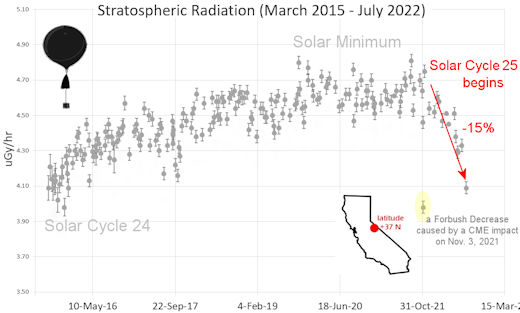
What's going on? Ironically, the radiation drop is caused by increasing solar activity. Solar Cycle 25 has roared to life faster than forecasters expected. The sun's strengthening and increasingly tangled magnetic field repels cosmic rays from deep space. In addition, solar coronal mass ejections (CMEs) sweep aside cosmic rays, causing sharp reductions called "Forbush Decreases." The two effects blend together to bring daily radiation levels down. .Who cares? Cosmic rays are a surprisingly "down to Earth" form of space weather. They can alter the chemistry of the atmosphere, trigger lightning, and penetrate commercial airplanes. According to a study from the Harvard T.H. Chan school of public health, crews of aircraft have higher rates of cancer than the general population. The researchers listed cosmic rays, irregular sleep habits, and chemical contaminants as leading risk factors. A number of controversial studies (#1, #2, #3, #4) go even further, linking cosmic rays with cardiac arrhythmias and sudden cardiac death. Technical notes: The radiation sensors onboard our helium balloons detect X-rays and gamma-rays in the energy range 10 keV to 20 MeV. These energies span the range of medical X-ray machines and airport security scanners. Data points in the graph labeled "Stratospheric Radiation" correspond to the peak of the Regener-Pfotzer maximum, which lies about 67,000 feet above central California. When cosmic rays crash into Earth's atmosphere, they produce a spray of secondary particles that is most intense at the entrance to the stratosphere. Physicists Eric Regener and Georg Pfotzer discovered the maximum using balloons in the 1930s and it is what we are measuring today. | | The official U.S. government space weather bureau | | | The first place to look for information about sundogs, pillars, rainbows and related phenomena. | | | Researchers call it a "Hubble for the sun." SDO is the most advanced solar observatory ever. | | | 3D views of the sun from NASA's Solar and Terrestrial Relations Observatory | | | Realtime and archival images of the Sun from SOHO. | | | information about sunspots based on the latest NOAA/USAF Active Region Summary | | | current counts of failed and deployed Starlink satellites from Jonathan's Space Page. See also, all satellite statistics. | | | Authoritative predictions of space junk and satellite re-entries | | | from the NOAA Space Environment Center | | | fun to read, but should be taken with a grain of salt! Forecasts looking ahead more than a few days are often wrong. | | | from the NOAA Space Environment Center | | | the underlying science of space weather |  | Marketing yourself on YouTube is hard without real organic views on your videos. You can buy organic YouTube views from and enjoy social boosting that is actually real. Highly recommended! |  | When looking for casinos to play online when the weather is bad, you can try the SkyCity Online Casino if you are located in New Zealand. If you are not from NZ you can try the Swedish page Svenska casino online to find suitable games, check out svenskacasinoonline.net. Always check your local laws before playing with real money.. |  | BestCSGOGambling is the best site for everything related to CSGO gambling on the web | | | These links help Spaceweather.com stay online. Thank you to our supporters! | | | | | | | | |  | |  |   | ©2021 Spaceweather.com. All rights reserved. This site is penned daily by Dr. Tony Phillips. | |

